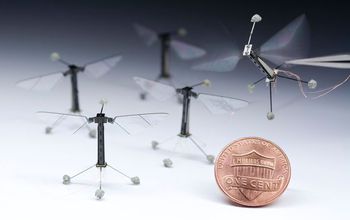Multimedia Gallery
Robotic bees, or RoboBees, developed by researchers at Harvard and MIT with support from NSF.
Inspired by the biology of a fly, with submillimeter-scale anatomy and two wafer-thin wings that flap almost invisibly, 120 times per second, the RoboBee takes its first controlled flight. The culmination of a decade's work, RoboBees achieve vertical takeoff, hovering and steering.
Credit: Kevin Ma and Pakpong Chirarattananon
Images credited to the National Science Foundation, a federal agency, are in the public domain. The images were created by employees of the United States Government as part of their official duties or prepared by contractors as "works for hire" for NSF. You may freely use NSF-credited images and, at your discretion, credit NSF with a "Courtesy: National Science Foundation" notation.
Additional information about general usage can be found in Conditions.
Also Available:
Download the high-resolution JPG version of the image. (514.6 KB)
Use your mouse to right-click (Mac users may need to Ctrl-click) the link above and choose the option that will save the file or target to your computer.
Related story: Flight of the RoboBee



